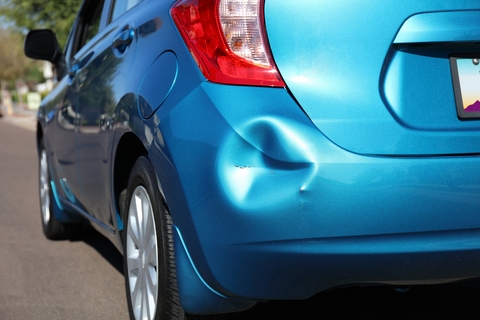What it Takes to Repair Annoying Dings and Dents

You parked your car in front of the local mall and went shopping. When you returned an hour or two later, you noticed a small dent on the side of door of your vehicle.
"Dings are particularly annoying because they show up like spots on a mirror, especially on dark colored surfaces," said Chuck Sulkala, executive director of the National Auto Body Council. "They also diminish the value of your vehicle."
What can be done to return your vehicle to its original condition without breaking the bank?
Paintless dent repair can remove dings or small dents affordably, Sulkala said. The procedure can sometimes return metal to its original shape without the need to repaint.
Traditionally, drivers left their vehicles with the autobody shop if they wanted to fix dents and dings. Repairs involved sanding, masking, priming and painting. The work was laborious and cost prohibitive for small jobs.
"Paintless dent repair usually is 50 to 60 percent less than the cost of traditional body shop repair and is faster," Sulkala said. "It's an affordable way of handling most dings and minor dents."
The places where vehicles usually get dents—doors, hoods, fenders and trunks—offer the best results for paintless dent repair. Those spots are typically made of thin, pliable metal and offer easy access. A paintless dent repair specialist can inner panels and gently push out the dent.
"We've taken out dents the size of a laundry basket," said Bill Garoutte founder of Elite Dent Alliance, which specializes in hail disaster repair. "We've even fixed vehicles pelted by four-and-a-half inch hail."
Paintless dent repair may be used on a wide variety of dents as long as the sheet metal is not stretched or the paint chipped, Garoutte said. Both Sulkala and Garoutte offered the following guidelines for vehicles with apparent minor dent repair:
- Location of the dent determines repair options. Trunks, all side panels, roofs and hoods are the best candidates for repair.
- Check for chips and scratches. Surfaces must be repainted even if dents are removed. Otherwise, water may interact with the metal and cause rust.
- Use a paintless dent repair specialist who knows your brand of vehicle.
- e
- Get references and proof of insurance before work begins.
- Consider removing dents and dings before trading in your vehicle. It may improve resale value.
- Avoid paintless dent repair for fenders and mirrors. Those parts usually are made of plastic or metal composite, which usually cracks or chips.
- Do not use paintless dent repair on stretched panels and dents on panel creases. In most cases both problems require traditional autobody repair. Ask your service advisor for assistance finding the right dent repair specialist.
"The first thing you should do is show your vehicle to a service technician and ask for advice," Sulkala said. "Put your vehicle in the hands of someone you trust. Repairing your vehicle according to your desires is just as important as trusting your Doctor to do what is right for you."